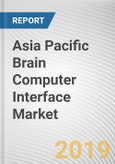Intensive research carried out to treat fatal brain disorders and injuries and government initiatives such as providing funds to encourage BCI research studies are likely to boost the market growth. However, ethical problems faced during research, i.e., using BCI to treat patients without obtaining informed consent, can act as a restraining factor for the market growth. In most of the cases, it is not possible to define or restrict the amount of information that can be retrieved from the patient. BCI is comparatively a nave technology, restricted only to laboratory research and many of its applications are yet to be commercialized.
The brain computer interface market is segmented based on types, applications and countries. The type segment includes invasive BCI, non-invasive BCI and partially invasive BCI technology. On the basis of applications, the BCI market is segmented into communication and control, healthcare, smart home control, gaming and entertainment and others. To study the country wise scenario in Asia-Pacific region, the market is bifurcated based on countries into China, Japan, South Korea, Australia and Rest of Asia (ROA). Many prominent players have been operating in the market including Nihon Kohden Corporation, Mind Solutions, Inc., Advanced Brain Monitoring, Inc. and others.
KEY BENEFITS
The study provides an in-depth analysis of the brain computer interface market with current and future trends to elucidate the imminent investment pockets in the market.
The current and future trends have been outlined to determine the overall attractiveness and to single out profitable trends for gaining a stronger foothold in the market.
The report provides information regarding key drivers, restraints and opportunities with impact analysis.
Quantitative analysis of the current market and estimations during the period of 20142020 have been provided to showcase the financial appetency of the market.
Porters five forces model analysis and SWOT analysis of the industry illustrate the potency of the buyers and suppliers participating in the market.
Value chain analysis in the report provides a clear understanding on the roles of stakeholders involved in the value chain.
BRAIN COMPUTER INTERFACE MARKET KEY SEGMENTS
The Asia-Pacific brain computer interface market is segmented based on types, applications and countries.
BY TYPE
Invasive
Non-invasive
Partially invasive
BY APPLICATION
Healthcare
Communication and control
Gaming and entertainment
Smart home control
Others
BY COUNTRY
China
Japan
South Korea
Australia
Rest of Asia (ROA)
KEY PLAYERS
Nihon Kohden Corporation
Mind Solutions, Inc.
Advanced Brain Monitoring, Inc.
Quantum Applied Science and Research, Inc.
Cadwell Laboratories, Inc.
OpenBCI
Cortech Solutions, Inc.
NeuroSky, Inc.
Emotiv, Inc.
Guger Technologies OEG
Methodology
The analyst offers exhaustive research and analysis based on a wide variety of factual inputs, which largely include interviews with industry participants, reliable statistics, and regional intelligence. The in-house industry experts play an instrumental role in designing analytic tools and models, tailored to the requirements of a particular industry segment. The primary research efforts include reaching out participants through mail, tele-conversations, referrals, professional networks, and face-to-face interactions.
They are also in professional corporate relations with various companies that allow them greater flexibility for reaching out to industry participants and commentators for interviews and discussions.
They also refer to a broad array of industry sources for their secondary research, which typically include; however, not limited to:
- Company SEC filings, annual reports, company websites, broker & financial reports, and investor presentations for competitive scenario and shape of the industry
- Scientific and technical writings for product information and related preemptions
- Regional government and statistical databases for macro analysis
- Authentic news articles and other related releases for market evaluation
- Internal and external proprietary databases, key market indicators, and relevant press releases for market estimates and forecast
Furthermore, the accuracy of the data will be analyzed and validated by conducting additional primaries with various industry experts and KOLs. They also provide robust post-sales support to clients.

LOADING...








